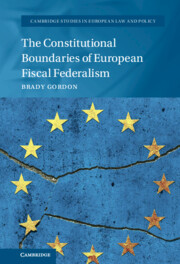Book contents
- The Constitutional Boundaries of European Fiscal Federalism
- Cambridge Studies in European Law and Policy
- The Constitutional Boundaries of European Fiscal Federalism
- Copyright page
- Basic Table of Contents
- Detailed Table of Contents
- Figures
- Acknowledgements
- Table of Cases
- Table of Legislation, Treaties and Conventions
- Abbreviations
- Part I
- Part II
- 5 The Emergent Centralized Architecture of European Fiscal Federalism
- 6 The Constitutional Boundaries of Economic and Monetary Union under EU Law
- 7 The Constitutional Boundaries of Member State Fiscal Sovereignty
- 8 Principles of Fiscal Federalism for the European Union
- Conclusion
- Proposed Directions for Future Research and Reform
- Bibliography
- Index
7 - The Constitutional Boundaries of Member State Fiscal Sovereignty
from Part II
Published online by Cambridge University Press: 07 April 2022
- The Constitutional Boundaries of European Fiscal Federalism
- Cambridge Studies in European Law and Policy
- The Constitutional Boundaries of European Fiscal Federalism
- Copyright page
- Basic Table of Contents
- Detailed Table of Contents
- Figures
- Acknowledgements
- Table of Cases
- Table of Legislation, Treaties and Conventions
- Abbreviations
- Part I
- Part II
- 5 The Emergent Centralized Architecture of European Fiscal Federalism
- 6 The Constitutional Boundaries of Economic and Monetary Union under EU Law
- 7 The Constitutional Boundaries of Member State Fiscal Sovereignty
- 8 Principles of Fiscal Federalism for the European Union
- Conclusion
- Proposed Directions for Future Research and Reform
- Bibliography
- Index
Summary
Chapter 7 examines whether the fiscal governance architecture enacted since the crisis is reconcilable with the constitutional boundaries of member state fiscal sovereignty underlying the EU legal order as a whole. It conducts a piece-by-piece deconstruction of the European governance framework to identify instruments which trespass on ultra vires and constitutional identity rulings of national constitutional courts. It finds that the new architecture is dependent, for its stable functioning, on instruments which are beyond the boundaries of the EU legal order and profess to bind national legislators in economic/fiscal policy, contrary to member state constitutional identity jurisprudence. By restricting fiscal autonomy and providing bailouts, the EU has sunk the foundation stones of a unitary model that is manifestly incompatible with the constitutional jurisprudence of its twenty-eight member states catalogued in this book. This is not only legally unsound, but economically ineffective and injurious to good principles of fiscal federalism.
Keywords
- Type
- Chapter
- Information
- The Constitutional Boundaries of European Fiscal Federalism , pp. 261 - 336Publisher: Cambridge University PressPrint publication year: 2022

